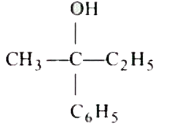On heating perchloric acid, it yields:
To solve the question regarding the products formed when perchloric acid (HClO4) is heated, we can follow these steps:
Step 1: Understand the decomposition of perchloric acid
Perchloric acid (HClO4) is known to decompose upon heating. The decomposition reaction involves the breakdown of HClO4 into several products.
Step 2: Write the decomposition reaction
The balanced chemical equation for the decomposition of perchloric acid can be represented as follows:
4HClO4→2ClO2+2O2+4H2O
Step 3: Identify the products
From the balanced equation, we can see that the products formed from the decomposition of perchloric acid are:
- Chlorine dioxide (ClO2)
- Oxygen gas (O2)
- Water (H2O)
Step 4: Conclusion
Thus, when perchloric acid is heated, it yields chlorine dioxide, oxygen gas, and water.
Final Answer:
On heating perchloric acid (HClO4), it yields chlorine dioxide (ClO2), oxygen gas (O2), and water (H2O).
---
Perchloric acid (HClO4) is known to decompose upon heating. The decomposition reaction involves the breakdown of HClO4 into several products.
The balanced chemical equation for the decomposition of perchloric acid can be represented as follows:
From the balanced equation, we can see that the products formed from the decomposition of perchloric acid are:
- Chlorine dioxide (ClO2)
- Oxygen gas (O2)
- Water (H2O)
Thus, when perchloric acid is heated, it yields chlorine dioxide, oxygen gas, and water.
On heating perchloric acid (HClO4), it yields chlorine dioxide (ClO2), oxygen gas (O2), and water (H2O).
Topper's Solved these Questions
- P-BLOCK ELEMENTS (HALOGEN & NOBLE GASES)BOOK - RESONANCE ENGLISHCHAPTER - P-BLOCK ELEMENTS (HALOGEN & NOBLE GASES)EXERCISE - EXERCISE-3 PART-1
12 Videos
- P-BLOCK ELEMENTS (HALOGEN & NOBLE GASES)BOOK - RESONANCE ENGLISHCHAPTER - P-BLOCK ELEMENTS (HALOGEN & NOBLE GASES)EXERCISE - EXERCISE-3 PART-2
13 Videos
- P-BLOCK ELEMENTS (HALOGEN & NOBLE GASES)BOOK - RESONANCE ENGLISHCHAPTER - P-BLOCK ELEMENTS (HALOGEN & NOBLE GASES)EXERCISE - EXERCISE-2 PART-3
15 Videos
- P-BLOCK ELEMENT (BORON AND CARBON FAMILY)BOOK - RESONANCE ENGLISHCHAPTER - P-BLOCK ELEMENT (BORON AND CARBON FAMILY)EXERCISE - PART - III : OLYMPIAD PROBLEMS (PREVIOUS YEARS) STAGE - V (INTERNATIONAL CHEMISTRY OLYMPIAD (IChO)) Problem 3
8 Videos
- PERIODIC TABLE & PERIODICITYBOOK - RESONANCE ENGLISHCHAPTER - PERIODIC TABLE & PERIODICITYEXERCISE - Advanced Level Problems
105 Videos
Similar Questions
Knowledge Check
In a set of the given reactions, acetic acid yields a product C. Product C would be :
 ACH3CH(OH)C2H5BCH3COC6H5CCH3CH(OH)C6H5D
ACH3CH(OH)C2H5BCH3COC6H5CCH3CH(OH)C6H5D
The number of peroxide linkages in perchloric acid is
View SolutionOxidation state of chlorine in perchloric acid is
View SolutionOn strong heating, chloric acid decomposes to:
View SolutionAssertion (A): The heat of neutralisation of perchloric acid, HCIO4, with NaOH is same as that of HCI with NaOH.
Reason (R ) : Both HCI and HCIO4 are strong acids.
View SolutionDry distillation of a mixture of the calcium salts of acetic acid and propionic acid will yield
View SolutionThe number of Cl=O bonds is perchloric acid is , "____________".
View Solutionβ−Hydroxy propanoic acid on heating gives acrylic acid.
Acrylic acid exists in two diastereomers.
View Solution
